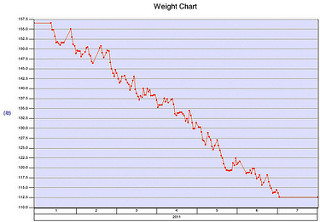Got Food Serving Smarts
Breakfast, lunch, and dinner - more Americans are eating out these days. It's nice to be able to sit back, relax, and not have to worry about fixing a meal. But food portions have increased steadily since the 1950s and many of us are eating too much.
In the 1950s a serving of French fries was 2.4 ounces, according to www.mealsmatter.org. Today, a serving of French fries is 7.1 ounces or more. The food industry, responding to market demands, produced glasses as big as pitchers and plates as big as platters.
Today, huge servings are so common we think they are "normal."
While many restaurants are giving us a good deal on food, it's a bad deal when it comes to your health. Vanderbilt University wellness experts, on their Health Plus Website, say many Americans could be "innocently overeating," and wonder why they're gaining weight.
An "Action on Obesity" conference report, published in the April 2005 issue of "Mayo Clinic Proceedings," cites some causes of weight gain: increased portion size, dining out at restaurants, and consuming energy-dense foods, such as snacks and carbonated drinks.
Eating out is okay if we keep serving sizes in mind. What's the difference between a portion and a serving? A portion is the amount you choose to eat, including return trips to the buffet table. A serving is a measured amount based on food pyramid groups. According to MayoClinic.com, we may be "overlooking an important part of a healthy diet - serving sizes."
And the serving sizes we need to eat in order to maintain a healthy weight may be smaller than we think. Calculating serving sizes is a learned skill, according to Mayo Clinic, and you need measuring cups, spoons, and a food scale to do it. You're not going to bring these things to a restaurant, so what's the solution?
Mayo Clinic says you can compare serving sizes to objects:
3 ounces of meat, fowl or fish = a deck of cards; 1 cup of vegetables = size of your fist; 1 apple = a baseball; 1/2 cup pasta = one ice cream scoop; 1 1/2 ounces of cheese - two dominoes; 1 cup dry cereal - a large handful
Can you continue to eat out and keep a healthy weight? Yes, if you follow these tips.
1. STUDY MENU OPTIONS. Ask your server if you can make any substitutions, such as veggies for French fries, and low-calorie salad dressings. Ask for vinegar and oil if low-calorie dressings are unavailable.
2. CHOOSE LOW CALORIE FOODS. These foods include grilled chicken, steamed vegetables, fresh fruit, and salad with dressing on the side. Choose whole grain bread and eat one serving (a slice or roll) only.
3. ORDER SUGAR-FREE DRINKS. In a brochure called "How Much Are You Eating?" the USDA says we should moderate our intake of sugar. One sugar sweetened carbonated beverage may contain 10 teaspoons of sugar. Instead of sugar sweetened drinks order plain water or unsweetened iced tea.
4. CHECK SERVING SIZES. Before you take one bite of food calculate the serving sizes on your plate. Eat half your meal (or less) if the servings are too large. Take the rest of your food home for another day.
5. EAT VEGGIES AND FRUIT FIRST. Many restaurants are serving meat, chicken, and fish portions that would feed two or more. Eating low-energy-dense foods (low-calorie foods that fill you up)will make it easier to eat one serving of protein.
6. EAT SLOWLY. It takes a while for the mind to realize you are full. Eating slowly and chewing your food well gives your mind time to process this fact. You'll also enjoy your food more. Stop eating the minute you feel full.
7. CHOOSE FRUIT FOR DESSERT. If fresh fruit is on the menu, choose it for dessert and ask the server to hold the whipped cream. After eating a huge meal you may wish to skip dessert. You also have the option of taking dessert home, cutting it into smaller servings, and freezing it.
Keep these tips in mind whenever you go to a restaurant. Share these tips with family members and friends. Your food serving smarts will help you to have a healthy and long life.
Copyright 2005 by Harriet Hodgson. To learn more about her work go to http://www.harriethodgson.com.
-
Lose Ten Pounds -- Permanently
You and I both know that it isnt actuall
-
8 Interesting Tips to Transform from Plus-Size to Normal-Size
A plus-size figure may shadow your enthusiastic and outgoing personali
-
A Beginners Guide to Protein Powders
Proteins are referred to as building blocks of the body and rightly so
-
Free Weight Loss Plan For People On The Go
We all want to have a great, healthy body. Men and women have always b
-
Exercise and the Effective Ways to Burn Fat
In order to find out just how much exercise to burn fat you have to ta
-
Demystifying Diet Myths
In todays modern culture wherein Paris H
- DON'T MISS
- Lose Belly Fat- Answers to Frequently Asked Questions
- The result of Hypnosis for weight loss and just how Does it Work
- Weight Loss Success With The South Beach Diet
- Be Healthy…Eat Dessert!
- Willpower and Self Hypnosis For Weight Loss
- Losing Weight Naturally – Fast Easy Weight Loss With Proper Goals…
- Diet Soda New Study Shows Relationship Between Diet Soda And Weight Gain
- DASH (High-Plant) Diet for Heart Health, Weight Loss and Diabetes Prevention/Control
- Avoid These Foods To Lose Weight
- Dangers Of Dieting - Dieting Truths You Need To Know




